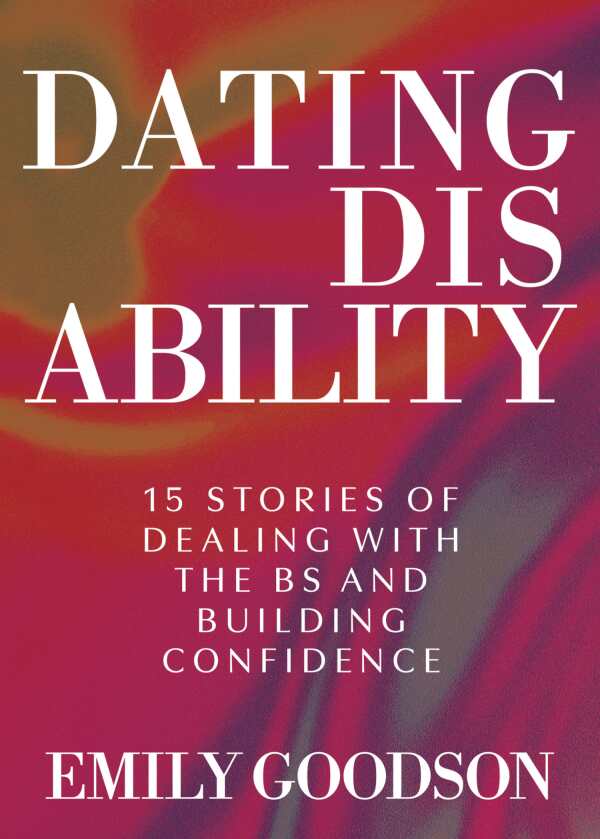Dating Disability
15 Stories of Dealing with the BS and Building Confidence
An intimate, revealing self-help resource, Dating Disability encourages seeking love after first learning to love oneself.
In the candid and welcoming memoir–cum–self help guide Dating Disability, disability advocate Emily Goodson details varied experiences with romance and dating while offering encouragement to others seeking meaningful partnerships.
At the age of eight, Goodson underwent surgery to correct a “vascular malformation” in her brain. The operation left her unable to talk and with lateral body impairment. Through physical therapy, she regained her speech capabilities. She now walks with an “altered gait” and has the use of one arm and hand. Goodson notes that the most damaging effects of her brain trauma were emotional and psychological, affecting her self-image and sense of social and romantic validity.
With elucidating humor and poignant revelations, Goodson utilizes a compact chapter structure to detail her teenage crushes, “visceral” yearnings, and later dating interactions. Expressing frustration over her prolonged periods of celibacy, she notes how her lack of sexual experience and negative perceptions of her disability undermined her dating self-esteem. She recalls flirtations and rejections and how a questionable matchmaking service once paired her with a “hiking enthusiast”; their date involved traversing a California beach trail, flanked by “crashing waves” and a troubling lack of guardrails.
Goodson’s engaging tone broadens as she observes that, even beyond physical disabilities, self-limiting perceptions become “deal-breakers” that can inhibit the successful pursuit of romantic relationships. Recounting her own “inner work” process, she advises seeking guidance from life coaches and therapists to minimize one’s critical personal judgments and redirect toxic thought patterns. Journaling is encouraged as a private form of expression and a “tracker” of “progress and missteps.” However, the general narrative flow is communicative and autobiographical; the book’s self-help suggestions are not in a fixed format with defined exercises or objectives, leading to some muddling.
At the book’s core is Goodson’s abbreviated yet impactful information regarding the historical treatment of disabled people. She asserts that this reprehensible legacy should be fully acknowledged, from the mass murder of disabled individuals during the Holocaust to the laws of the eugenics movement and centuries of persistent abuse and mockery. By further noting that disabled people are often “underestimated, infantilized, and perceived as in constant need,” Goodson emphasizes her lifelong determination to avoid such marginalized stereotyping. This tenacious integrity exists as an intriguing complement to her romantic optimism and resilience.
In relating certain dating encounters, the book is too often short on vivifying details. A casual meeting at an upscale bar involved lively conversation and plentiful “sauv blanc,” yet the evening was shadowed by Goodson’s anxieties about how her handsome companion would react when she revealed her disability. Though she describes being “terrified” by her dilemma, the aftermath of the encounter is not detailed.
In another situation, Goodson’s “love interest” watched her struggle to serve a homemade meal. The background regarding this relationship, including regarding whether her date’s refusal to help was motivated by cruelty, chauvinism, or oblivious ignorance, is hazy. And in a heartfelt and eloquent passage, Goodson describes her current connection to someone who shares a similar “leg length discrepancy,” stating that his awareness of her “reality” has been “deep” and “life-changing.” This friendship is perhaps platonic, though, and its undefined breadth is distracting.
A compelling self-help resource, Dating Disability balances personal anecdotes with practicable knowledge, championing individual validity all the while.
Reviewed by
Meg Nola
Disclosure: This article is not an endorsement, but a review. The publisher of this book provided free copies of the book and paid a small fee to have their book reviewed by a professional reviewer. Foreword Reviews and Clarion Reviews make no guarantee that the publisher will receive a positive review. Foreword Magazine, Inc. is disclosing this in accordance with the Federal Trade Commission’s 16 CFR, Part 255.

